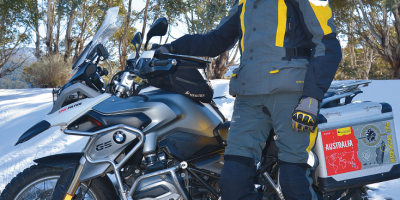The distress beacon mass debate!
For adventure riders, some way of letting the world know you’re in trouble is vital. Sending an SOS has come a long way since Gilligan spent years marooned, desperate for a little Ginger. These days there’s some serious technology available to those who risk the great unknown, but the two that most commonly come up for discussion are the EPIRB and the SPOT. Both have good points, but they’re not the same thing. Here’s some impartial direction to help decide which is best for you.
The first step to deciding which one is right for you is to understand what both of these devices are.
EPIRB: letters of the law
‘EPIRB’ stands for Emergency Position Indicating Radio Beacon, and to be pedantic we’re actually not interested in EPIRBs.

We’re interested in PLBs: Personal Locator Beacons.
![]()
To be classified as an EPIRB, a distress beacon must be able to “operate for a minimum of 48 hours and float upright when deployed in water”. It was necessary to have a definition and a set of minimum performance standards so laws could be drafted governing the requirements for marine vessels. You can tote around an EPIRB and it’ll do the job, but land-based distress beacons are generally more compact. They also meet a different set of criteria, being required to operate for a minimum of 24 hours, and even though they’re required to float unassisted, they’re not required to be self-righting while floating. For these reasons, PLBs, no matter how they’re labelled, are not EPIRBs according to the law.
As the name suggests, a PLB sends out a distress signal that alerts a rescue co-ordination centre that someone’s in trouble. The signal also allows the location of the beacon.
That’s a PLB.
SPOT: the difference


‘SPOT’ stands for Satellite Personal Tracker, and while it too can send a distress signal, that’s not its sole function, and it doesn’t send that signal on the same path or to the same people as the PLB.
The most popular feature on the SPOT is the OK button. One touch and your position (lat/long) and a short, preset message is sent via email/SMS to up to 10 designated addresses or mobile numbers. The email also has a link to that exact location on Google Maps. Typically, a message might say, “I’m OK” and tag on a latitude and longitude. That must be a great comfort to family and friends.
Next up is a Help button, which sends an email/SMS to your chosen addresses giving your position and a short message, typically “I need help”. This is for non-life-threatening situations and relies on those receiving the message to work out where you are and/or where you’re heading, and to guess what type of help you might need. This email would also have a link to the location on Google Maps.
Both SPOT and PLBs are one-way communication devices. They can send, but they can’t receive, so no-one can ask why you need help.
SPOT also offers a SOS button (a ‘911’ button on the first generation). Press that one and the unit will acquire its coordinates from the GPS network, then send the location, along with a distress message, to a GEOS International Emergency Response Center in the US. It’ll continue to send every five minutes until it’s cancelled or the batteries go flat – typically, up to seven days on a new set of AA Lithium-Ions.
Finally, SPOT offers a tracking service. Once activated by pressing and holding the OK button for five seconds, it transmits your location every 10 minutes for 24 hours. Everyone can go online and track your progress, superimposed on Google Maps.
All that makes the SPOT sound like the go, and on for many riders it is.
But there’s a catch.
PAYG
Both the SPOT and PLBs use satellite networks for communication. The big advantage of that is widespread coverage. Where a mobile phone is often useless in secluded areas, satellite coverage is much better. However, as Sat-phone users will tell you, satellite connectivity isn’t a guarantee of coverage.
The big difference between a SPOT and a PLB is the SPOT being a privately owned and operated subscription service, while a PLB has its performance parameters set by law and uses a dedicated, worldwide search-and-rescue satellite network. The SPOT uses a different network of communication satellites – the same one as Sat phones, but not in the same way as sat phones – to pass its message along to the rescue centre. (It uses the simplex system of the satellites. Just like an ordinary mobile phone may not allow speech due to poor coverage, but will still send an SMS, the simplex system allows a vastly greater scope for transmission than a sat phone’s duplex system). Someone in that rescue centre will then notify rescue services that you’re in trouble.
If you activate a PLB, someone, somewhere, will be listening.
If you activate the SPOT, someone will be listening, as long as you’ve paid your subscription.
The signal path
So imagine the worst has happened. You’re writhing in pain in the dust 50km west of Condobolin. Your leg’s busted, your hand’s a swollen mess and you need help. There’s no mobile phone coverage so you hit the PLB. What happens?
First off, a distress signal is sent. The satellites orbiting Earth pick up the signal and send the info to the Australian Maritime Safety Authority (AMSA).
When you bought your PLB you should’ve registered the unit with AMSA, supplying some specific information. AMSA is the registry for all PLBs and EPIRBs in Australia. Someone at AMSA will look up your information and try to call you. If you don’t answer, they’ll call your listed emergency contact. The idea is to establish that it’s a genuine distress call they’ve picked up. If you answer their call and tell them you’re sitting at home watching a Wiggles concert, AMSA will do nothing more towards a search-and-rescue operation.
If, however, you don’t answer, but your emergency contact does and says, “The stupid bugger is riding out west somewhere”, AMSA will instigate a search operation that may include sending police or rescue services, or even dispatching an aircraft, depending on which is likely to get there fastest or which is most appropriate.
Pay to play
What happens when someone hits the ‘911/SOS’ button of the SPOT?
Pretty much the same things actually, except where the PLB sends out a distress signal to a search-and-rescue satellite network monitored by search-and-rescue services worldwide, the SPOT uses privately owned Globalstar communication satellites to send a signal to the GEOS International Emergency Response Center in the US, letting them know there’s a problem.
Similar to the PLB registration, subscribing to the SPOT service involves supplying some relevant information. The Emergency Response Center will go through the same process to establish the call is for real, then will notify the appropriate emergency responders based on your location and personal information (if you’re in Australia, the distress call and information will be handed to AMSA), as well as notifying your emergency contact about the receipt of a distress signal. The distress signal is sent with your latitude and longitude, your device number, and a link to a Google Map with your position pinpointed, accurate, says SPOT, to within five metres.
So it’s not totally different to the PLB, except your emergency contact is notified, and there’ll be that extra time between setting off the beacon and the notification coming to Australian authorities from the US call centre. Once AMSA has the information, the process is the same as for a PLB.
There’s no homing signal from the SPOT, so rescuers will rely totally on the position they’ve been given, and it’s a commercial venture. If you’ve let your subscription lapse, you really are on your own.
There’s human involvement in both cases, and therefore the possibility of error, but whether one is more efficient than the other we’re unable to verify.
Count the cost
Cost shouldn’t be a deciding factor with life-saving equipment, but with two similar devices it’ll be a consideration.
An Aussie-made PLB will cost about $300 from an Aussie store (be careful buying a PLB from overseas. It will carry a code in its signal saying it’s from the country of purchase, and that country will receive the initial notification the beacon has been activated. Time will be lost while that country notifies Australian authorities. Beacons from the US – which may seem cheap on e-bay – don’t meet the Australian standard and can’t be registered here.)
Once you’ve paid that purchase price, you’re good to go. Battery life is 10 years. Walk out of the store, turn that puppy on, hit the button, and emergency services will start looking for you.
Prices on the SPOT vary. There’s a SPOT Gen 3 that sells for around AUD$239 from AdventureMoto.com.au and it’s a good unit. Again, be careful about buying low-priced units, and especially be careful about buying from overseas. They’ll work, but they won’t be supplied with the Australia C Tick of approval for use on the Australian system, nor will they have any Australian warranty or back-up.
But once you’ve purchased your SPOT you’ll still need to subscribe to the service, and that’s another US$115 per year or so, every year. For that you get the 911/SOS function, Check In, and Ask For Help. The Track Progress – offering 24-hour, constant tracking on Google Maps – costs another US$49.99 per year (we’re using US dollars here because the company is in the US, and that’s how it lists its prices. You’ll be charged in US dollars, too).
So if you take the most basic view, seven years coverage from a PLB will cost $300. Seven years coverage from a SPOT will cost a minimum of AUD$2014 (the $239 purchase price, plus 7 x US$115 converted to Aussie dollars at the current rate). That assumes SPOT doesn’t increase its subscription rate in the next seven years, of course.
A direct comparison of that nature isn’t really valid because the SPOT offers a different and wider set of services than the PLB. And you might decide to not subscribe for a year or two for various reasons.
Remember, a PLB can send an internationally recognised distress signal from anywhere in the world on a set of dedicated search-and-rescue satellites. That’s its sole purpose. A SPOT can send a distress signal via satellite to a privately run US rescue centre who’ll notify Australian authorities, but it can also keep you in touch with a wide support network, both reassuring friends and family and asking for help in non-life-threatening situations.
It’s up to you to decide whether or not you want a dedicated distress beacon for life-or-death situations, or a tracker with the ability to send a distress signal.
Bits and pieces
There are a few other considerations. A PLB like the KTI we carry has a battery life of 10 years and a 10-year warranty. The SPOT runs on Lithium-Ion batteries which will last around 14 days in SPOT tracking mode, or send about 1900 OK/Help messages.
Also, where a PLB has global coverage, the SPOT has a few black spots in areas like the poles and some parts of southern Africa. That’s probably not a big deal to Australian adventure riders, but it’s a fact. Australia and a considerable stretch of ocean surrounding our sunburnt country are completely covered by SPOT. ‘Coverage’ by SPOT is defined on its website (www.findmespot.com) as the messenger being able “to successfully deliver a single message during a 20-minute period, based on network availability”. The unit puts out multiple messages for the OK/Help and SOS signals. To send a successful message it has to hit a satellite and be relayed to a ground station at the same time. Because the satellites are orbiting, it sends the signal multiple times to increase the likelihood of a successful connection. An OK message will be sent three times over 20 minutes (only the first successful message will be delivered. Your contacts won’t be pestered with multiple copies of the same message). The Help message will send every five minutes for one hour or until it’s cancelled, and all messages that get through will be delivered. The SOS will send every five minutes until cancelled or the batteries go flat.
SPOT also has the ability to cancel a Help or SOS message. If you no longer need emergency services, you can send a cancel message by hitting the button again. It’ll flash red and send a message letting family, friends and emergency services know you are OK and no longer need them.
A PLB can be turned off, but you’ll need to call to notify SAR services. As AMSA’s representative put it: “They’ll be thrilled to know you’re all right.” There’s no penalty for accidental activations.
No matter where you travel in the world, including the poles and the vast expanses of the oceans, you can chuck your PLB in your kit and know you’ll be able to send a distress signal if you need to, and it’ll be monitored and dealt with by dedicated SAR services. The SPOT will allow sending of a distress message from almost anywhere in the world (and Globalstar is working at increasing its coverage), but the initial distress message will be dealt with in the US, no matter where you are.
Your call
So which one’s for you?
The SPOT offers some really nice features and it’s something that can be used on every ride, even if you’re not in trouble, even if you’re just trailriding near your home. The PLB might sit in your kit from the day you buy it until the battery expires and, hopefully, not be used even once. Neither of these devices will guarantee a helicopter or ambulance at your position in short order, but both will get the message from a desperate, and no-mobile-phone-reception location to the right people about as quickly as it can be done. The PLB is a search-and-rescue dedicated locator that will connect you to government-regulated search-and-rescue services at the touch of a button. The SPOT will put you in touch with people who will notify search-and-rescue services, but otherwise will keep you in touch with a preselected support network of family and friends.
The PLB has a one-off cost, while the SPOT has a purchase price and an ongoing subscription cost.
Us? We decided to carry both.

If a situation is really extreme – and we’ve seen it – we want our distress signal with AMSA as fast as it can possibly be done. But the peace of mind offered by the SPOT to friends and family, and the ability to ask for help without a distress signal is important too.
Only you can decide which will best suit your needs.













Comments